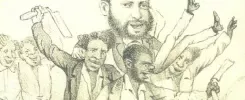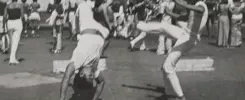By Mariana P. Candido.

Histories that problematise colonialism
The Angolan city of Benguela, also known as Ombaka in Umbundu, is the capital of the province of Benguela with a population of 2,135,094 inhabitants, according to the 2014 censuses. I could say that it was founded in 1617 by a Portuguese explorer who has been memorialised in books and monuments, but doing so suggests that it was an uninhabited region before the arrival of European conquistadores. Quite the opposite: the Ndombes/ Mundombes, in Portuguese, were settled in the territory that became known as Benguela under different leaders. As cattle raisers, the Ndombe population was characterised by mobility due to environmental constraints.
By the time Manuel Cerveira Pereira arrived with his 130 soldiers in 1617, Peringue ruled the land and was recognised by his subjects as the landlord of the territory located between the Cavaco and Coringe Rivers. According to Cerveira Pereira, as soon as the Portuguese disembarked the inhabitants of the bay “arrived with the intention to disturb.” One can imagine the surprise of Peringue and his people when the Portuguese leader arrived with 130 armed soldiers. Peringue moved away with his cattle and his subjects, probably to avoid conflict. The bay was aptly named Baia das Vacas, or Cattle Bay, due to the abundance of cattle.
The Portuguese conquistador misunderstood Peringue’s retreat as a military defeat. In the following weeks and months, Cerveira Pereira’s troops attacked nearby villages and described their raids as guerras de conquista, or war of conquest. In the process, Ndombe and other nearby populations were kidnapped, enslaved, and shipped to Luanda, the capital of the Portuguese colony of Angola. In 1618, just one year after his arrival, Cerveira Pereira reported sending at least two ships loaded with enslaved individuals and cattle to Luanda. Thus enslavement, sale, and deportation were intrinsic to the Portuguese presence in Benguela. In fact, the arrival of the Portuguese represented the displacement of the local Ndombe population, their resettlement into nearby regions, and the consolidation of the raids as a mechanism to terrorize the local population.
The slave trade expanded during the seventeenth century. Initially, enslaved Ndombe men, women, and children were sent to Havana, Cartagena, and Lima. Scholars have found documents from the 1600s that indicate the presence of men and women identified as originally from Benguela, or Nganguela further in the interior, in places as far as Buenos Aires or Havana. These enslaved individuals worked in the early colonial centers in the Americas, as well as in the mines and fields. With the expansion of colonialism in Brazil, including the demand for labor in the gold and diamond mines in Minas Gerais as well as sugarcane plantations in Pernambuco, Salvador, and Rio de Janeiro, a more extensive slave trade with Brazil was consolidated in the 1700s. To attend to this demand violence spread inland, with Portuguese officers directly participating in the capture, enslavement, and sale of Ndombes, Kakonda, Kilengues, and other groups. It is difficult to assess how these individuals identified themselves since their historical existence is registered only in documents written by Europeans. West Central African populations were always identified by their place of capture or political affiliation, and it is not clear if these were the ethnic identity that people employed at this time.
Different sizes of political organizations existed in the region that we call Angola today. There were small groups of pastoral communities such as the Ndombe; larger communities such as Kakonda, who occupied the Hanya, a key commercial node in the interior of Benguela; and centralised states such as Wambu/ Huambo. Commercial caravans from inland states such as Bie or Wambu crossed Kakonda’s territory to Ombaka. In Ombaka inland caravans acquired dried fish, shells, and other goods in exchange for copper, ivory, and war captives. Thus, a complex commercial network existed in this region that connected coastal and inland populations.
Further archeological research is needed to learn more about the history of Ombaka before the arrival of the Portuguese conquistadores. We know there was a settlement there that included temporary markets. After 1617 the landscape changed completely. Portuguese forces built a fortress to protect the Portuguese garrison from French and Dutch attacks, who were interested in joining the slave trade there. However, the garrison did not prevent the Dutch attack and occupation of Benguela from 1641-1648. In 1649 the expedition of Governador Salvador Correia de Sá of Rio de Janeiro regained control of the port. This initiated a close relationship between colonial officers and traders based in Brazil and their peers in Benguela. Both towns were under Portuguese colonial control. The priest António Vieira stated, “Without Angola, there is no Brazil.” After the 1650s Brazilian-born troops patrolled Benguela. They joined Portuguese-born men who had spent years in Salvador, Recife, or Rio de Janeiro before crossing the Atlantic to serve in the Portuguese colonies on the African continent. In many ways these agents, whether Brazilian born or not, arrived in Benguela influenced by their experience in Brazil, including expectations and ideas regarding slavery and racial hierarchies.
Female clothing, Angola, 1786-87. In Louis de Grandpre, Voyage à la côte occidentale d’Afrique, fait dans les annés 1786 et 1787. Paris, 1801, vol. 1, p. 75 (public domain image).

By the 1700s the Portuguese Crown relied on Brazilian-born officers to rule, patrol, and expand colonial control in Benguela. Many of them were convicts, degredados in Portuguese, who had committed crimes or attempted to defraud the Crown. This included Manuel de Sousa, a black man condemned to exile in Benguela for bad behavior in Recife in the 1710s. More serious crimes such as homicide also led to exile. This was the case with Felipe Nunes and António Freire, both white men from Bahia, who were sent to serve in the colonial forces in Benguela as a way of serving their sentence. Women born in Brazil also settled in Benguela, including Ana Maria Vieira from Bahia, who lived there with her husband, also from Bahia, in 1771. However, some Brazilian-born women went to Benguela to carry on trade, such as Joana Josefa da Conceição, identified as a Black woman from Minas Gerais. Joana Josefa da Conceição traveled alone to Benguela, which may suggest she went there to engage in the commerce of enslaved individuals, the most important commercial activity in Angola until the 1850s.
The links between Benguela and Brazil became even stronger with the expansion of the transatlantic slave trade, with Rio de Janeiro becoming the most important slaving arrival port in the Americas. According to the Slave Voyages database, more than 1,217,000 enslaved Africans arrived in Rio de Janeiro between 1570-1870. Although most of them arrived from Luanda, important numbers also arrived from Benguela. During the era of the transatlantic slave trade an estimated 760,000 enslaved individuals were deported from Benguela. Historians have been able to reconstruct the experiences of some of those who were enslaved, such as the case of Dona Leonor de Carvalho Fonseca, Páscoa, Bibiana and Thereza2. However, the majority left no trace in the historical documents.
From the 1650s to 1822 people born in the colony of Brazil were key agents in Benguela’s society and economy. Men married elite women, which consolidated business partnerships, and established powerful families. Foreign men and local women raised children that benefited from the social position of both parents. Vicente Alves da Cunha, baptised in the Nossa Senhora da Conceição da Praia in Bahia, occupied the position of captain of Benguela. In 1812 he married dona Cristina das Neves from the fortress of Quilengues in the interior. Dona Cristina was herself a Luso-African, part of the local colonial elite. Her father, Joaquim de Barros Cunha, was from Portugal, but her mother’s place of origin is not clear. Marriage alliances between merchants favored both sides and inserted Brazilian born traders and soldiers into local networks in Benguela. This allowed them to access land, slaves, and a large number of dependents, who were subsequently recruited as farmers, security personnel, and porters, among other occupations. Marriages between African women and Brazilian-born men and other foreigners provided one way to maintain a close relationship with the colonial state and the Atlantic world.
In many ways, Brazilian-born officers became dynamic auxiliary agents of the colonial state, helping to expel Ndombe people from their lands and enslaving vulnerable ones. Employed by the colonial state or as criminals in exile, Brazilian-born individuals participated actively in the kidnapping of free people. As members of the Portuguese troops, they raided villages, seized crops, and captured people, who were then sold to slave traders anchored in the Benguela bay. Traders and colonial agents born in Rio de Janeiro and Salvador integrated into the larger Benguela-based merchant community through sharing the same interests and probably the same urban spaces, including attending Masses at the Nossa Senhora do Pópulo Church. Understanding the role of Brazilian-born traders in the Atlantic commerce in Benguela problematizes our understanding of colonialism, colonial elites, and the intricacies of a system that led to the deportation of millions of Africans to the Americas.
Mariana P. Candido is a lecturer in the Department of History at Emory University and a research consultant for the Angolan Roots project.
Notes:
1 Frederick P. Bowser, African Slave in Colonial Peru, 1524-1650 (Stanford: Stanford Univ. Press, 1974), 40–41; David Wheat, “The First Great Waves: African Provenance Zones for the Transatlantic Slave Trade to Cartagena de Indias, 1570–1640,” The Journal of African History 52, no. 01 (2011): 1–22; Kara D. Schultz, “‘The Kingdom of Angola Is Not Very Far from Here’: The South Atlantic Slave Port of Buenos Aires, 1585–1640,” Slavery & Abolition 36, no. 3 (2015): 424–44.
2 Mariana P. Candido, “African Freedom Suits and Portuguese Vassal Status: Legal Mechanisms for Fighting Enslavement in Benguela, Angola, 1800–1830,” Slavery & Abolition 32, no. 3 (2011): 447–59; Charlotte de Castelnau L’Estoile, Páscoa et ses deux maris: Une esclave entre Angola, Brésil et Portugal (Paris: PUF, 2019); Mariana Armond Dias Paes, “Shared Atlantic Legal Culture: The Case of a Freedom Suit in Benguela,” Atlantic Studies 17, no. 3 (July 2, 2020): 419–40.
To learn more about Benguela see:
Alves, Rogéria Cristina. “Marfins africanos em trânsito: apontamentos sobre o comércio numa perspectiva Atlântica (Angola, Benguela, Lisboa e Brasil), séculos XVIII-XIX).” Faces da História 3, no. 2 (2016): 8–21.
Bezerra, Nielson Rosa. Escravidão, farinha e tráfico Atlântico: um novo olhar sobre as relações entre o Rio de Janeiro e Benguela (1790-1830). Rio de Janeiro: Fundação Biblioteca Nacional – Minc, 2010.
Candido, Mariana P. An African Slaving Port and the Atlantic World: Benguela and Its Hinterland. New York: Cambridge University Press, 2013.
———. “O limite tênue entre a liberdade e escravidão em Benguela durante a era do comércio transatlântico.” Afro-Ásia 47 (2013): 239–68.
———. “Os agentes não europeus na comunidade mercantil de Benguela, c. 1760-1820.” Saeculum – Revista de História 29 (2013): 97–123.
———. “Jagas e sobas no ‘Reino de Benguela’: vassalagem e criação de novas categorias políticas e sociais no contexto da expansão portuguesa na África durante ps séculos XVI e XVII.” In África. Históricas conectadas, edited by Alexandre Vieira Ribeiro, Alexsander Lemos de Almeida Gebara, and Marina Berther, 39–76. Niterói: PPGHISTÓRIA – UFF, 2014.
———. “As comerciantes de Benguela na virada do século XVIII: o caso de dona Aguida Gonçalves.” In Laços Atlânticos: África e africanos durante a era do comércio transatlântico de escravos, edited by Carlos Liberato, Mariana P. Candido, Paul E. Lovejoy, and Renée Soulodre-LaFrance, 231–58. Luanda: Ministério da Cultura/ Museu Nacional da Escravatura, 2017.
———. Fronteiras da escravidão. Escravatura, comércio e identidade em Benguela, 1750-1850. Benguela: Universidade Katyavala Bwila/ Ondjiri, 2018.
Ferreira, Roquinaldo. “A supressão do tráfico de escravos em Angola (ca. 1830-ca. 1860).” História Unisinos 15, no. 1 (2011): 3–13.
———. “Biografia, Mobilidade e Cultura Atlântica: A Micro-Escala Do Tráfico de Escravos Em Benguela, Séculos XVIII-XIX,.” Tempo 10, no. 2 (2006): 23–49.
Freudenthal, Aida. “Benguela – da feitoria à cidade colonial.” Fontes & Estudos 6–7 (2011): 197–229.
Gomes, Armindo Jaime. “Fundamentos da ekula no poder tradicional mundombe.” Mulemba. Revista Angolana de Ciências Sociais 6, no. 6 (12) (2016): 179–202.
———. Os sobas. Apontamentos étno-histórico sobre os Ovimbundu de Benguela. Benguela: Aguedense, 2002.
Kajibanga, Victor. Coreografia Rural. Uma contribuição para o estudo sociocultural de Benguela. Benguela: KAT, 2009.
L’Estoile, Charlotte de Castelnau. Páscoa et ses deux maris: Une esclave entre Angola, Brésil et Portugal. Paris: PUF, 2019.
Paes, Mariana Armond Dias. “Shared Atlantic Legal Culture: The Case of a Freedom Suit in Benguela.” Atlantic Studies 17, no. 3 (2020): 419–40.
Parreira, Adriano. “A Primeira Conquista de Benguela.” História, Lisboa 12, no. 128 (1990): 64–68.





